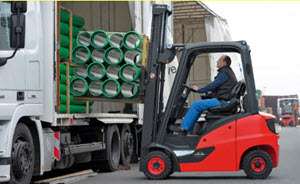In Europe, the market for electric forklift trucks has been growing exponentially and is expected to continue growing at 13% per annum until 2030. The electric forklift truck market size is expected to reach £37 billion in Europe by 2030.The markets in UK and Germany are growing fastest.

Forklift trucks such as reach, counterbalance, pallet trucks and stackers improve efficiency and this has impacted positively on the market. The innovations in the battery technology, particularly the introduction of lithium ion batteries for forklift trucks has had a huge impact on the sales of electric forklift trucks. The lithium ion battered powered forklift truck sales are expected to grow at 20%.
In this blog, we look at different battery types for electric forklift trucks and their advantages and disadvantages. There are three main types of batteries available for forklift trucks. They are:
- Lead Acid batteries
- Fast Charge Lead Acid batteries
- Lithium Ion batteries
Lead Acid battery powered forklift trucks
The Lead Acid battery was invented in 1859 and with new innovations has improved in performance since. They are used in a variety of applications including cars and forklift trucks. The lead is submerged in sulphuric acid to allow a controlled chemical reaction. The oxygen is the active element as lead oxide reacts with hydrogen ions to form water. The lead then reacts with sulphuric acid to form lead sulphate. The movement of ions through the electrolyte creates the current flow. The reaction is reversed to charge the battery.
There are a number of benefits of using lead acid battery powered forklift trucks. It is one of the cheapest to run. These types of batteries are not only dependable but inexpensive when viewed on a cost-per-watt basis. However lead-acid batteries require regular maintenance. The battery needs to be charged after your shift has finished. Just before you start your next shift, check and top up the water levels if needed after the battery has been fully charged and allowed to cool. If you top-up before it is charged, the water level would be too high and it will bubble over the top of the cells and go into the battery tank leading to further complications and corrosion. This would probably make the forklift truck inoperable for the shift.
The lead acid batteries should only be charged when it has used up 80% of its power. Prematurely charging the battery would damage it. The forklift truck lead acid battery would cost £5k and would normally last between 5 and 10 years. Having to replace the battery prematurely would be expensive. Lead acid batteries are removed from forklift trucks to charge them.
Fast Charge Lead Acid battery powered forklift trucks
The fast charge lead acid batteries are the same technology as lead acid batteries but are built differently. They are coupled with high-efficiency chargers to allow them to be opportunity charged. This allows forklift trucks shorter charging times and hence be able run longer throughout the day to increase productivity including during break times. The battery remains in the forklift truck while it is being charged. The advantages of fast charging are cost savings, higher productivity, safety, and maintenance improvements. Depending on how they are used, the trade-off may be the battery life.
The fast charge lead acid batteries require topping up and maintenance. The forklift trucks with fast charge lead acid batteries also require a full 14 hour charge once a week.
Lithium Ion Battery powered forklift trucks
The lithium ion batteries are extensively used in computers, mobile phones, electrical vehicles including cars and forklift trucks. A lithium ion battery is made up of an anode, cathode, separator, electrolyte and positive and negative current collectors. The anode and cathode store the lithium. The electrolyte carries positively charged lithium ions from the anode to the cathode and vice versa through the separator. The movement of the lithium ions creates free electrons in the anode which creates a charge at the positive current collector. The electrical current then flows from the current collector through a device being powered like a forklift truck to the negative current collector. The separator blocks the flow of electrons inside the battery. Click here to see the animation of how the lithium ion battery works.
Lithium ion batteries are basically maintenance free and require no manual handling. They are a sealed unit and hence no top up is required. However, if you run a lithium ion battery flat, it is likely that it is unrecoverable, unlike lead acid batteries. These batteries are expensive and a counterbalance forklift truck lithium ion battery could cost about £15k to £20k.
Lithium ion batteries can be opportunity charged and the charging times are much faster. However, lithium ion battery powered forklift cannot be operated for long periods without charging.
Each battery type has its advantages and disadvantages. You need to look at your forklift truck requirements to select the ideal battery type for your application.
In this blog we have just look at the battery powered forklift trucks and their advantages and disadvantages based on the type of the battery. However, battery powered forklifts trucks have a number benefits compared to the fossil fuel powered ones and have been gaining market share. One major benefit is that they do not produce dangerous fumes and hence your warehouse does not require special ventilation and they are quiet to run.
Wallace School of Transport including Forklift Training in London is a fully accredited RTITB company with over 50 years' experience. You can be trained either at your own work site or at Wallace Centre in Park Royal. If you have any questions, call Wallace Forklift Training on 020 8453 3440, choose option 3 or click here to email us.
